Music
One of the most rewarding parts of a yoga concert is seeing the musician shine. Like Sanem Kalfa, who sensed so well what was happening on the mats, and even started jamming with the humming fridge. And Erik Bosgraaf, who was to perform for a thousand people the next day, and was thrilled about the intimacy and space for creativity in the Jungle.
Not only visitors, also musicians enter a different kind of focus during a yoga concert—a new creative layer. Over the years, a core group of musicians has gradually emerged, whom I introduce on this page (see further down an overview of all musicians who have participated over the past years). The drawings below were made during a yoga concert by live painter Tali Farchi.
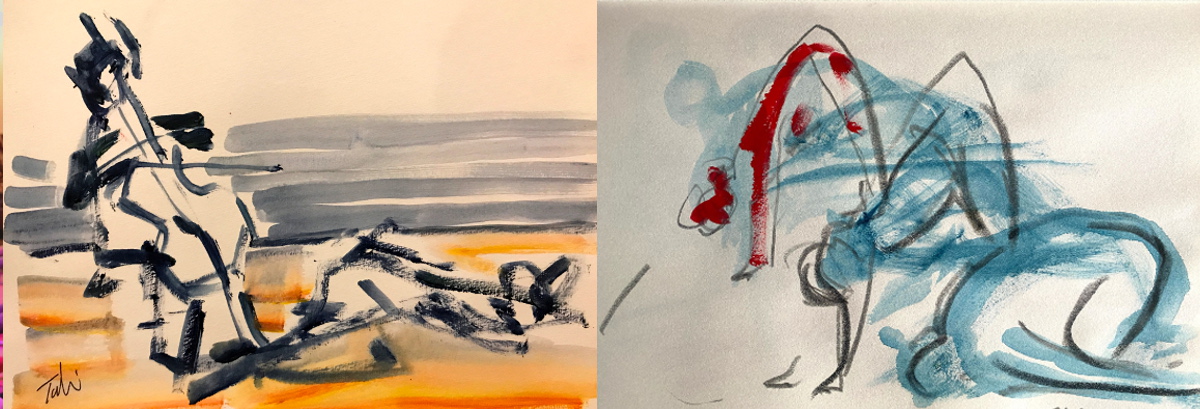
Mola Sylla
At the first yoga concert by Senegalese Amsterdammer Mola Sylla, held in the Amstelpark, a few musicians came to experience the yoga concert on the mat. They praised his simplicity, “with which he can say so much.” He surpassed that at his second performance. He began playing a small African guitar (the xalam), and because he has such an amazing voice, I expected him to use it during the second posture. But he kept playing the same chords, also during the third posture — when I recited a poem — and during the subsequent postures, long enough that it became hypnotic, as if on the spot he had invented an African Canto Ostinato, waiting until the very last posture to finally sing — and by then he had built the tension so well that everyone, stretching in the reclined butterfly posture opened up to his voice.
Below is a short impression of a somewhat rain‑soaked yoga concert in the Amstelpark.
Erik Bosgraaf
He plays, Erik likes to say, the most hated instrument of all: the recorder. And yet he tours as a highly requested soloist around the world. There’s a gentle enchantment in Erik’s playing. So we circled around the yogis in the Jungle, as I improvised lines of poetry and he responded with his flute — equally virtuosic and sensitive. “Start close in,” said the David Whyte poem, and that’s what we did. Afterwards, Erik said this setting demanded more of him than playing with an orchestra for a large audience — it was more intimate, more exposed. During a yoga concert, musician and audience alike start close in, and meet deeply - open, naked and vulnerable.
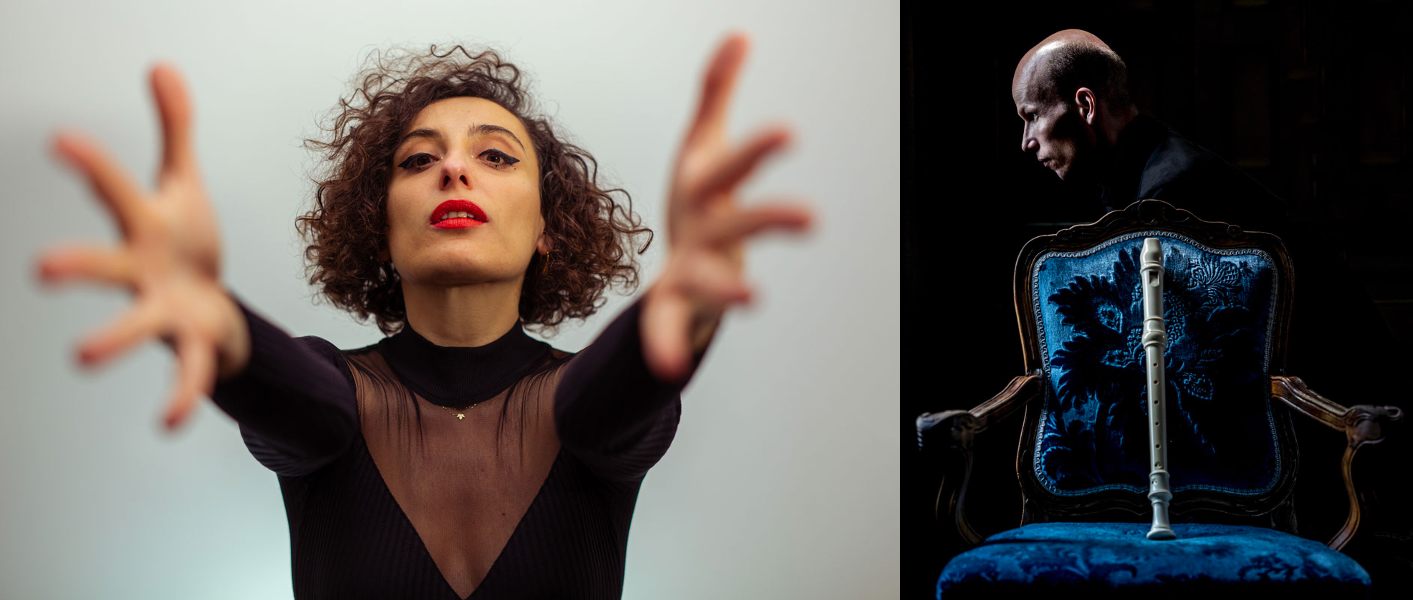
Sanem Kalfa
When Sanem Kalfa was featured as artist in focus at North Sea Jazz and curated her own program, she decided her performances would be about confrontation. “It's a combination of distinctive pain and pleasure, because all those confrontational moments leave a calm smile on my face. I find them holy moments.” These words could very well describe a yin yoga class that, as soft as it is, also brings confrontation, in a ritual that “sanctifies” the body. The yoga concerts suit Sanem perfectly: her voice, her cello playing, and especially her willingness to face the moment — to feel the darkness and resistance everyone meets on their yoga mat, and to include everything playfully, even the hum of a fridge.
Like some other musicians (Farid Sheek, Sinan Arat), she has sung Rumi’s poetry — see the video below.
Sinan Arat
It seemed inevitable that I would use Rumi’s Song of the Reed, the famous opening of his magnum opus Masnawi, for the first yoga concert with Sinan Arat: his music embodies the whispers of the reed. Not only does Sinan play the ney — the classical reed flute and Rumi’s favorite instrument — he also comes from Turkey, where the legendary poet spent most of his life and where he is known as mevlana, teacher.
On the website of the Netherlands Wind Ensemble, Sinan describes his music as an invisible bridge of breath that connects everyone: “a bridge from stone to human, from heart to cosmos, from silence to the Big Bang, from multiplicity to unity.” During the yoga concert, I wove these words into the class, as Sinan breathed his music. In his hands, the reed flute sounds as Rumi intended: tender, sensitive, and full of nostalgia for the reedbed from which it came.
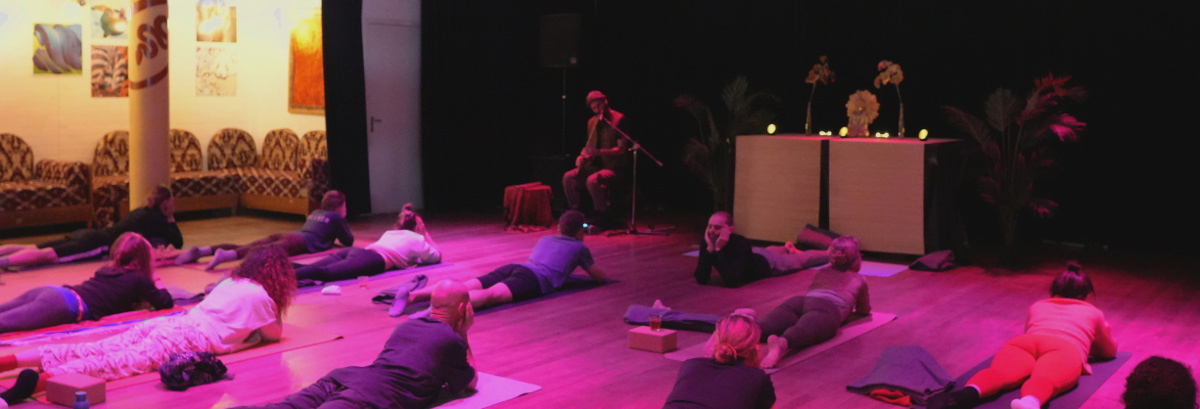
Ernst Reijseger
His first yoga concert was a mesmerizing performance in the Jungle, deeply sensitive and at the same time irrepressibly playful. Ernst Reijseger can make music from anything. His play flows in the moment, and so he brings everyone into the moment with him. An improvisation beast, newspaper the Volkskrant aptly called him. In the video below, you can catch a glimpse of that concert. Attendees said afterwards that from their posture they occasionally had to peek at what he was doing — they couldn’t place the sound he was pulling from his cello.
Ernst has a beautiful website, featuring his albums, downloads, streams, and several videos in which filmmaker Werner Herzog, cellist Andrew Yee, and others praise him in words both warm and spot on: springmusic.nl.
Dymphi Peeters
There’s something about singer musician Dymphi Peeters’s performances that is both extraordinary and elusive. Yes, her two yoga concerts were already specials and lasted two hours. But both times something happened. First, in the majestic Vondelkerk, when everyone felt we collectively sank into silence. Attendees said afterwards they lost track of time, as though they had been part of an ayahuasca ceremony. Then during the national Remembrance Day on May 4, we held a ritual yoga concert to remember and honor the dead. An emotionally charged, connecting experience — and, again that gentle stillness.
I was there and can’t deny: the name intuitive somatic music which she uses on her website, is well earned. Dymphi’s voice and music reach into deeper layers of consciousness, expressing stored emotions, so that the body can relax and the mind can still. With her voice and various instruments — alongside the kora, she uses flutes, drums, the sansula, the shrutibox, and more — she creates a journey passing through many places, singing a song from elsewhere: a deep, “whole making” Song of Yoga.
More about her and her music can be found on her website: dymphi.com.
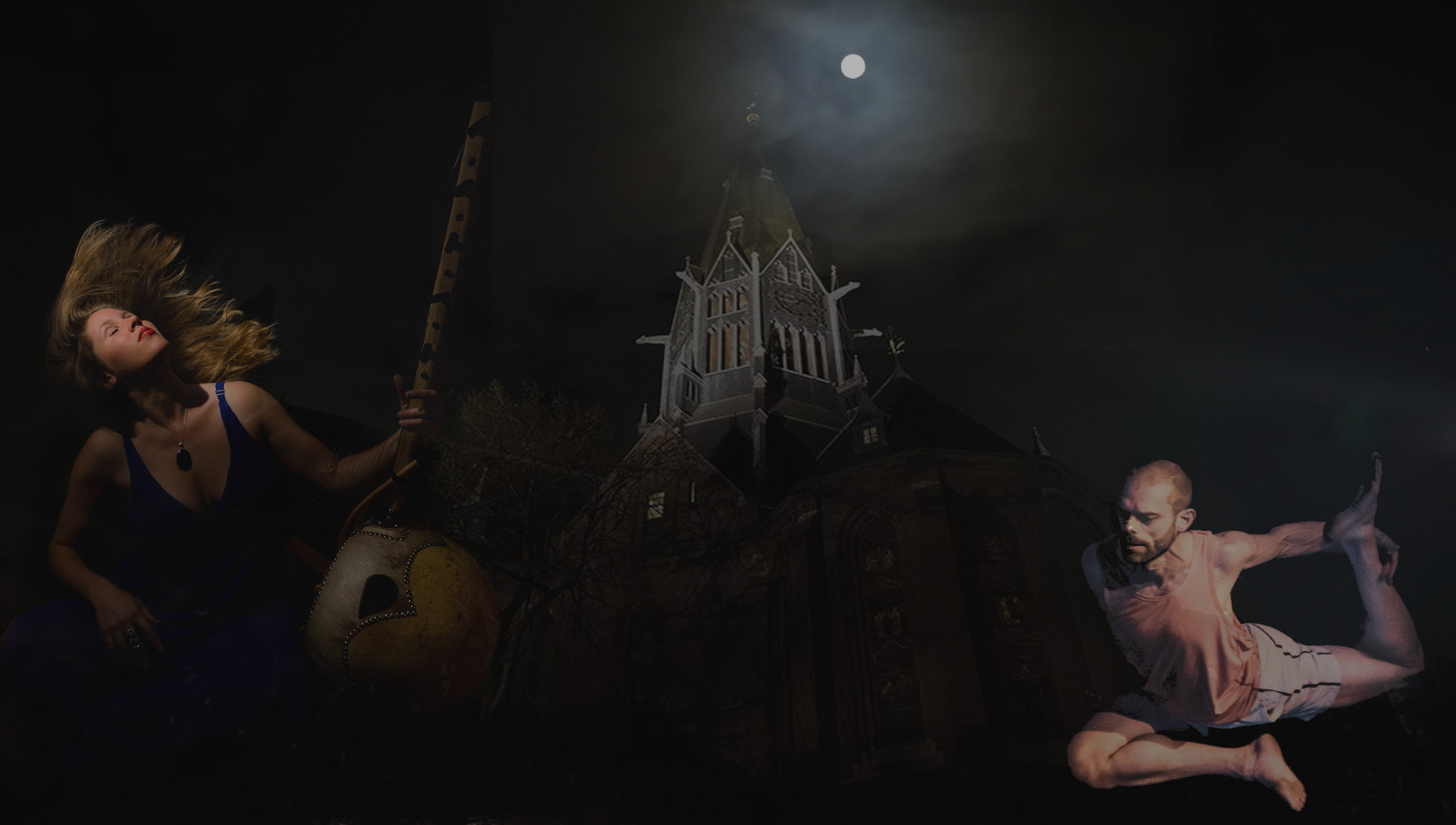
Couple Positive
Over the past years, a warm bond has formed with Couple Positive, founded on a passion for music and improvisation: Ania Brzezińska with her tender whispering trumpet and voice, and Hassie Dune with his warm, playful bass lines. On top of that came a shared appreciation for the poetry of Wisława Szymborska, who—like Ania—hails from Poland. Together we created a yoga concert featuring poems sung in Polish and English (by Ania), and recited in Dutch (by me). With their improvisational skills, it’s always a pleasure to weave music, poetry, and yoga into a natural whole — as if we’d rehearsed it all along!
They also have their own website: couple-positive.nl. From a yoga concert in the summer of 2024, I made a little clip: an ode to Rumi, to the blossoming nature in Amstelpark, and to these musical friends.
Farid Sheek
What stood out during his first yoga concert in the Jungle, was how effortlessly he filled the space, how naturally himself he was at the piano, with broad, free-flowing improvisation that always returned to a calm intimacy. Farid Sheek plays for subscribers of the Concertgebouw and the residents of Paleis Noordeinde just as easily as for yogis in the Jungle or Amstelpark, because, as he says, “it comes from the heart.” And so he keeps coming back — with his daf, a traditional Persian instrument he plays like wildfire, or at the piano, which he lets flow like a river. His grandfather was a Sufi master, his father a well‑known Iranian musician, and Farid himself composed a musical piece in honor of Rumi — all references for a mystically infused Song of Yoga concert.
In a secret double life, Farid was trained as an IT specialist, which shows in his self‑built website faridsheek.com.
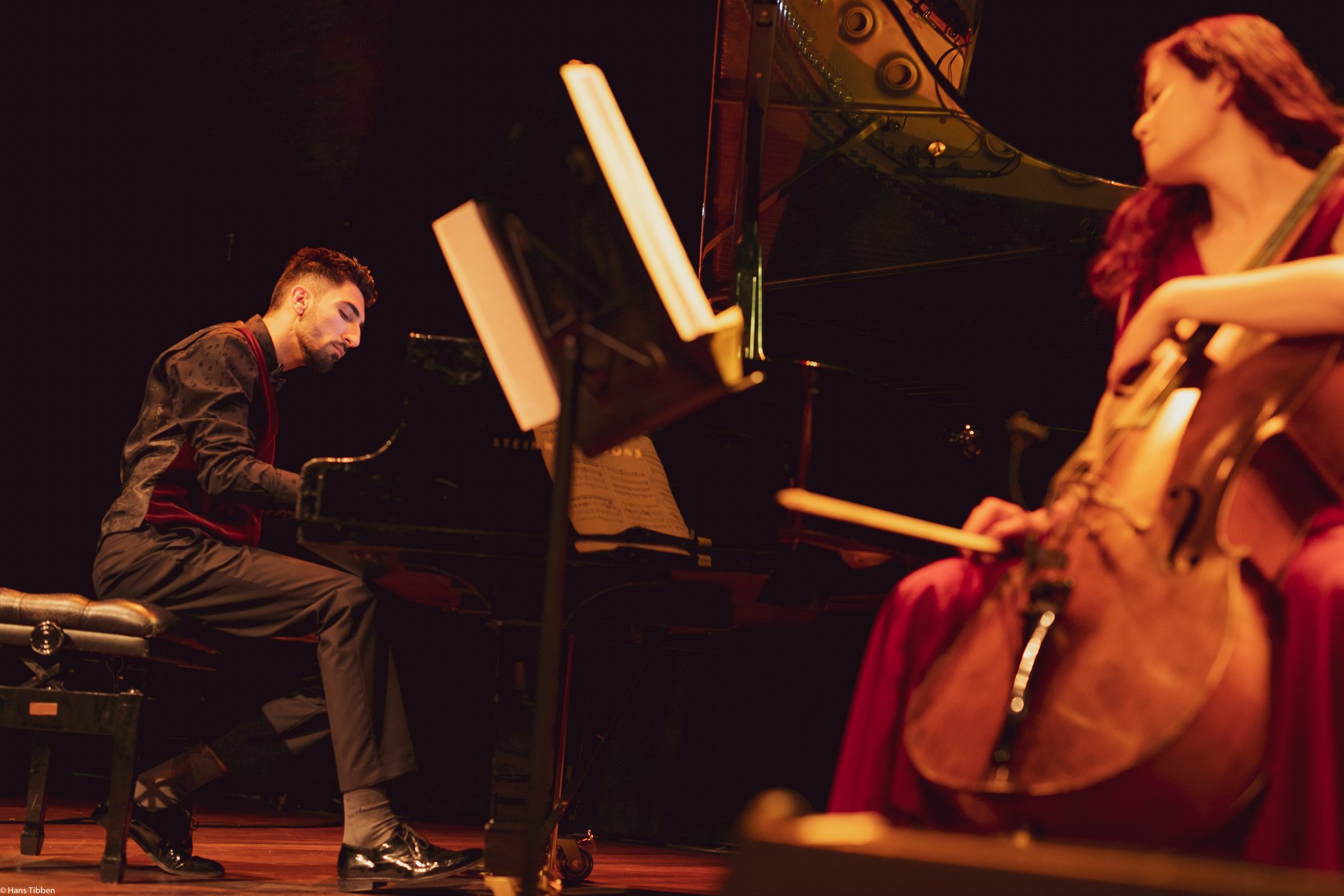
Marynka
Marynka’s improvised piano sounds suit the yoga concerts: intuitive, quiet, tender, with refined rhythms that always carry a spirited edge. This collaboration has already resulted in four yoga concerts. In the clip below, you see a glimpse of what precedes a yoga concert. The pianist and the poet-yoga teacher each prepare in their own way — and together.
Marynka’s music and more information can be found on her website marynkanicolai.com.
Wouter Schueler
On stage, Wouter Schueler regularly swings with the New Cool Collective and his funky crossover band Sinas. In recent years, spirituality has increasingly sneaked into his music, with lay down concerts, meditation music, and performances during Ecstatic Dances. That led to two beautiful yoga concerts in which he provided a soft, deep Song of Yoga with his saxophone, bansuri, and singing bowls.
You can follow Wouter’s activities via facebook. The photo below is from a legendary yoga concert in the Jungle, where I recite the last poem from Rainer Maria Rilke’s sonnets for Orpheus — and the reed flute, that is a bansuri.
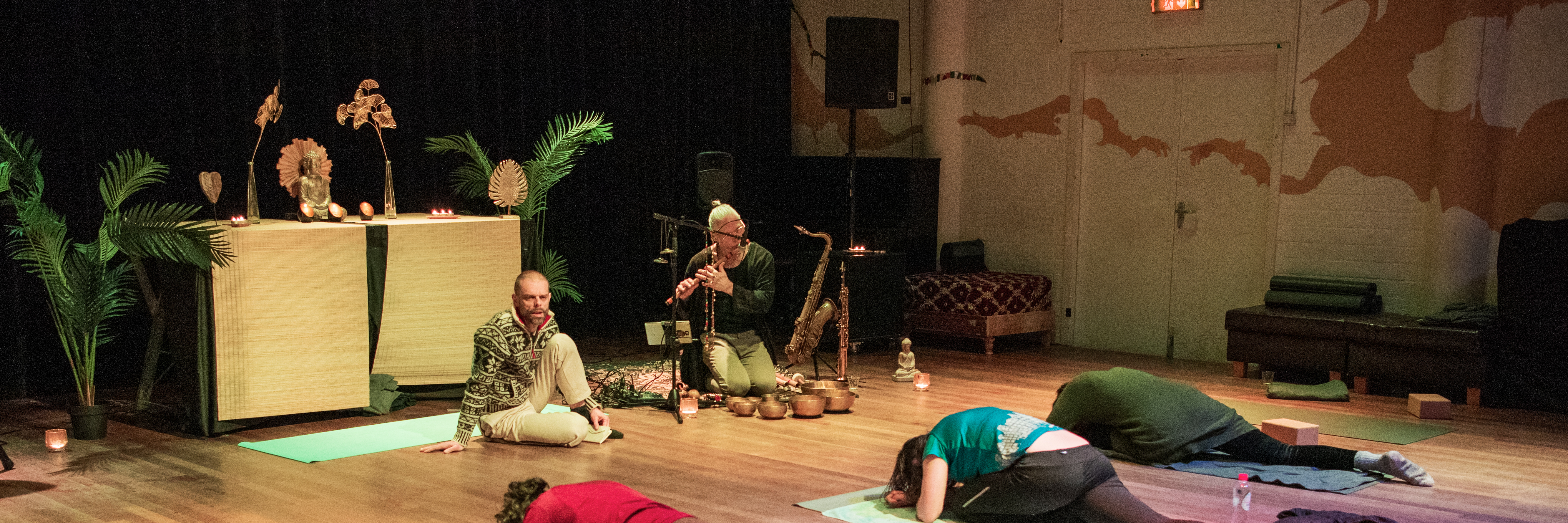
Fralalai
Many of the musicians I work with have been trained at a conservatory and seasoned on mainstream classical and improv stages. The Italian harpist and singer Fralalai found her own path, in the spiritual niche. She was impressive during her yoga concerts, with her gift for improvisation and the depth of her music. The tenderness of her harp, the fiery call of her drums, and her angelic voice — all bring about silence.
This once led to a special yoga concert centered around the poetry of Mary Oliver: Journey to Blackwater Pond. At this pond, Mary Oliver wrote, ‘the tossed waters have settled after a night of rain’. In the same way, Fralalai leads us to dark waters in ancient forests, tossing up feelings only to soak them with her voice — softening, settling.
Her music and more information can be found on fralalai.com.
Moira van Damme
This website is full of it, and I also draw on photographer Moira van Damme’s eye for beauty in the flyers and posters for the yoga concerts. Her photographs carry a poetic force that resonates with the poems I use and with what I hope to convey through the concerts.
The experience of beauty is the dissolving of subject and object, a merging with the whole — in other words, a mystical experience.
Whether it’s a piece by Max Richter, a poem by Rumi, or a photograph by Moira, it brings us closer to the elusive wonder of life.
More of her photography and information about her projects can be found on Moira’s website: aparla-femme.nl.
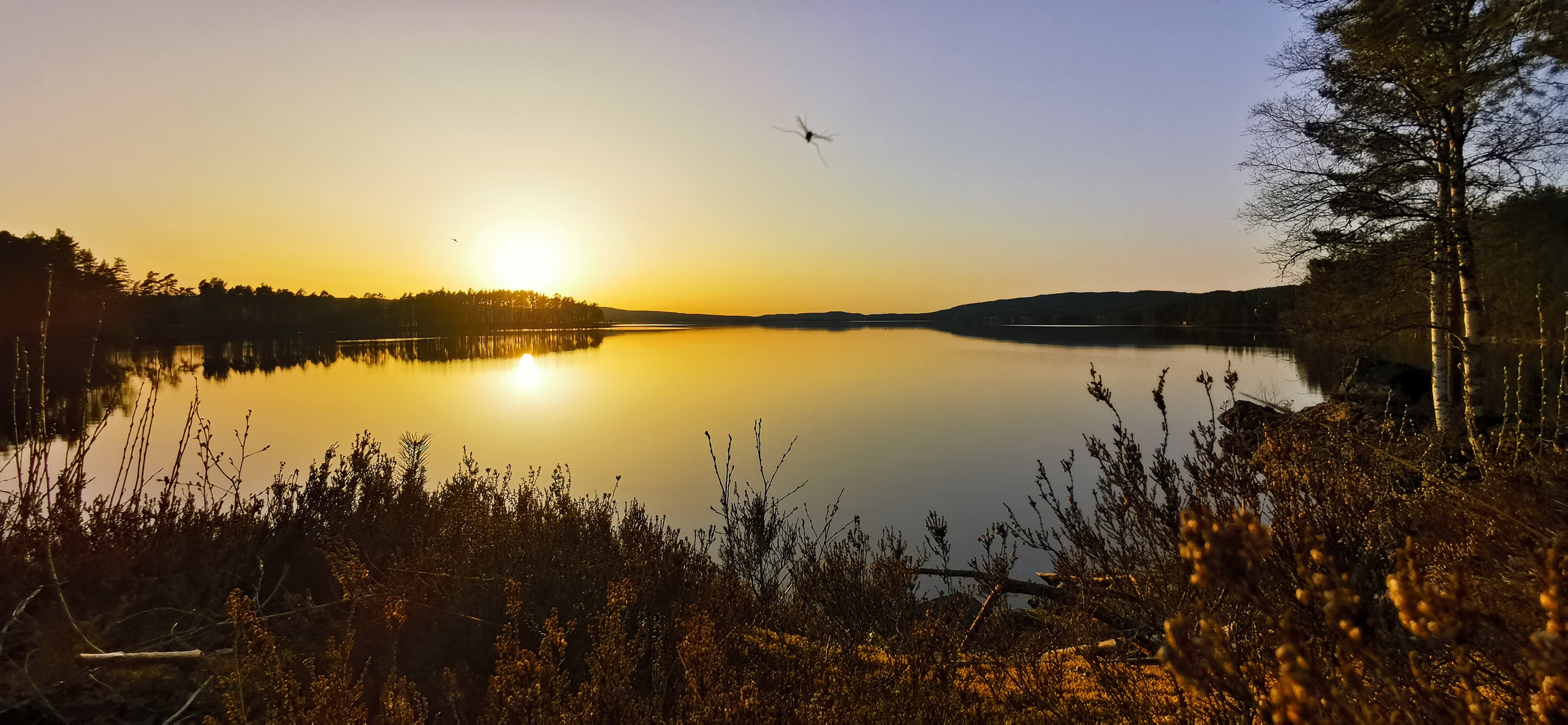
Chronos of yoga concerts
Song of Yoga developed out of cooperation and is nourished by a rich diversity of musicians, each of whom brings their own sound and color, temper and spirit. The following musical partners, in chronos or order of appearance, brought their kairos to the project:
Maite Hes (piano) – Fralalai (harp, voice) – Wouter Schueler (sax, bansuri, sound bowls) – Milan Mes (trumpet, sound art) – Marynka (piano) – Farid Sheek (piano, daf) – Tammo Heikens (sitar) – Lucas Stam (cello) – Didge Jerome (didgeridoo) – Veronica Vir (gong, sound bowls) - Ania Brzezinska (trumpet, handpan) – Hassie Dune (n’goni) – Ernst Reijseger (cello, voice) – Dymphi Peeters (voice, kora, flutes, drums) – Kees van Boxtel (bansuri) – Sinan Arat (ney, voice).
In the second season, the following musicians made their first appearance: HA!Man (cello, piano, vocals) - Mola Sylla (voice, percussion) - Hashem Kabreet (hang) - Krystl (voice, hang) - Sanem Kalfa (voice, cello) - Erik Bosgraaf (recorder) - Terence Samson (percussion) - Genetic Choir (vocals).